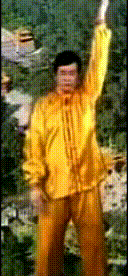SECONDARY LOOKOUT EXPERIMENTS
Parent Page : The Practical Panorama
This page is very secondary. It is a library of less important ideas,
Extra Exercises
These exercises may be good to play around with once you can do it, but i think they may confuse the beginner.1. In the context of exercising the peripheries and general eye-health, i find Paul McCartney's Yoga Exercises for Your Eyes (2.36 mins) a very good sequence.
2. Stretch out your arms to the sides, turn your hands inwards, and wiggle your fingers, then slowly move them upward, then down – trace out and recognise the shape of your field of vision, the whole oval shape.
 3. Put your hands together, as in prayer, and hold them up in front of your eyes; you will get a feeling of how it is to see without any central focus point... (seeing like an insect).
3. Put your hands together, as in prayer, and hold them up in front of your eyes; you will get a feeling of how it is to see without any central focus point... (seeing like an insect).
4. If you are indoors, or there's no wind outside.
Find a blank sheet of A4, fold it in half (for some stability), and hold it 4'' or 10cms. away from your eyes. Focus your eyes on it, but concentrate on and look at the interesting things happening all around it.
Move it farther away, step by step, until it's a relaxed arm's length away. Keep focusing on it, but concentrating on everything happening all around it.
'Gong like' Exercises
There are a number of 'Gong like' exercises which i find stimulate panoramic seeing. This may be useful if you already know the exercises. However learning the exercises in order to learn panoramic sensing woulod be a complex detour.
The main problem is that almost all teachers do these exercises with their eyes shut!
Chi Gong – 8 Brocades
Focusing on the Peripheries
The 5th exercise of the 8 Brocades is remarkable, it is called "The Wise Owl Gazes Backwards". It is equally remarkable that most teachers do it with the eyes closed.To look as far as you can see, you must look, as the name of the exercise implies, like an owl does – with the eyes wide open! – the only YouTube videos which i can find showing this even vaguely are
Qigong Ba Duan Jin – 8 Brokate 0.50 to 2.00 and Wise Owl Looks Behind
Falun Gong
Falun Dafa exercise no 3 is good, but even Master Li does it with his eyes closed. I obviously learnt wrong, because i do it with my eyes open – and i'm rather happy that throughout my life, i have so consistently learnt things wrong.
 Exercise Three
Exercise Three
These two movements are the basis of Exercise Three. I think the one using opposite hand movements is better.
Exercise Two is also good, but very similar to my Exercise 1. above.
Last time i looked online for the very good, practical, and clear videos, which i learnt with, they were no longer there. They were replaced with a poetical mystical nonsense text which i could not understand... If you are interested and find any good Falun Dafa videos online, please tell me.
Other Ideas
Panoramic seeing results in the opposite of screwing up the eyes and staring. Maybe at times it's good to start by just physically open your eyes as wide as they will go.
Disrupt and confuse your habitual focusing. Wave your hands around chaotically in front of your eyes for a few seconds, then look at the peripheries.
Humans are familiar with the passive use of panoramic seeing when we gaze vacantly into space. This is only a limited central area of the field, but if you find yourself gazing into space, vacantly, try and hold on to the feeling (maybe by listening) and "wake-up".
I have heard of people using panoramic vision in a limited central area when relaxed cycling. This seems semi-subliminal, almost like when daydreaming, and some people do it naturally while leisurely cycling. It all helps, so i've no objection to doing it, when there are no obstacles or people to have accidents with. It would be irresponsible to use it intensively when cycling. It would be dangerous to practice when driving.
Please continue with The Various Forms of Listening Meditation
Back to Chapter One : The Animal Teachings
Back to THE PANORAMA SENSES Priority Pages